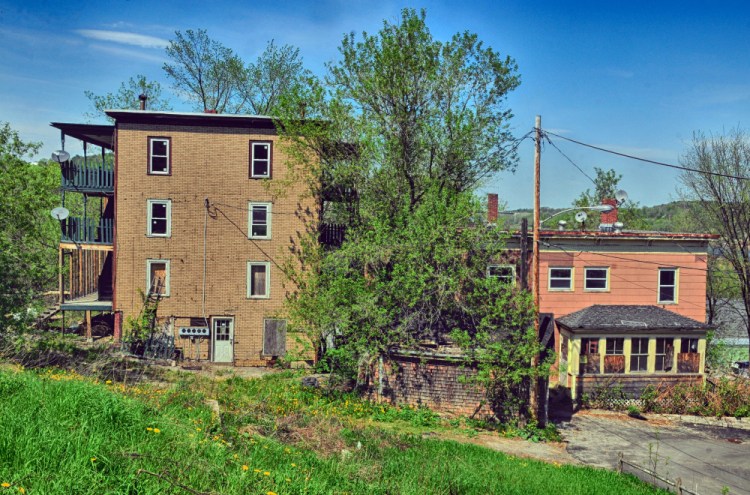AUGUSTA — Hoping to accomplish some addition by subtraction, this fall the city had dilapidated buildings on abutting lots at 11 State St. and 15 Morton Place, one of which was leaning on the other, torn down.
Taking one of the properties generated some level of controversy earlier this year when some city councilors expressed concerns accepting the “gift” of the donated property could set a precedent for other building owners anxious to get rid of buildings they don’t want.
But now that the worn-out buildings are down, city officials hope to sell the properties and return them to the tax rolls — though that could well be as one combined property, instead of two separate properties.
Part of the idea of taking the two properties and demolishing the run-down, structurally deficient old buildings on them was that the two properties, if combined, could be more marketable together than separately.
Matt Nazar, the city’s development director, said 15 Morton Place is such a steep lot that it might be better used as part of a larger property, instead of trying to put a new building on the same spot where the old one previously stood.
“Morton Place is very steep, so it would be a lot easier to build on the State Street lot and use the Morton Street lot for parking, or for at least some lawn and trees,” Nazar said recently.
Nazar said that while doing so would require City Council approval, he expects the city to sell the properties, probably after first checking with the Augusta Housing Authority, which is independent of the city, to see if officials there might be interested in them as potential sites to have new housing built.
If housing authority officials aren’t interested in the lots, the city probably would put them up for sale. Any proceeds from those sales would go, following recent city practice, into a fund reserved to pay for the costs of demolishing hazardous or dilapidated buildings in the city.
That same fund paid for the $38,600 cost of demolishing the two structures.
“Both of them were unsalvageable,” he said.
The buildings were torn down, together, from Nov. 6 to Nov. 9, according to Robert LaBreck, facilities and systems manager for the city.
In 2012, when it was owned by a different owner from the most recent owner, the four-apartment 11 State St. property was ordered vacated by Rob Overton, a city code enforcement officer, out of concern that the decks providing the only access to the upper floors were unsafe and could collapse. It has been vacant ever since.
Overton said at the time that city officials checked the condition of the decks after a visit to 15 Morton Place, which backs up to the property. The two buildings actually touched each other, he said.
City officials had boarded up 15 Morton Place months ago, and it had been the target of at least one break-in. Code officers, a public works crew and police were at that site when they noticed the condition of the State Street building’s decks.
The back deck and stairway structure of the State Street building, according to Overton, was in such poor condition it appeared to be held in place by the adjacent building at 15 Morton Place.
The city already owned the adjacent property at 15 Morton Place, according to City Manager William Bridgeo, having taken it for nonpayment of taxes.
Bridgeo said the city considered both buildings dangerous firetraps, and that both had attracted squatters.
In 2014, 11 State St. was sold by its previous owner, Kenneth Ouellette, to Anthony Thomas and Le Nhu Truong for $20,000, according to city tax records.
Nazar and Overton said the new owner was unable to complete renovation to bring the building up to code. Overton said he ordered Thomas to repair or remove the State Street building, but Thomas told him he didn’t have the money to do so. Thomas offered it as a donation to the city instead.
City councilors voted, 5-2, in June to accept the donation, with councilors Linda Conti and Harold Elliott voting against it because of concern that accepting the property might set a precedent, giving building owners to who fail to maintain their buildings a way to get rid of them.
Other councilors said the two abutting properties presented a unique situation that shouldn’t set a precedent, and that taking the property would be in the best interest of taxpayers. They also said leaving the dilapidated State Street property in place would make it harder for the city to resell the Morton Place property.
The former three-story, brown-and-green building at 11 State St. was built in 1885. The former red-and-brown four-unit building at 15 Morton Place was built in 1900, according to city records.
Keith Edwards — 621-5647
Send questions/comments to the editors.





Success. Please wait for the page to reload. If the page does not reload within 5 seconds, please refresh the page.
Enter your email and password to access comments.
Hi, to comment on stories you must . This profile is in addition to your subscription and website login.
Already have a commenting profile? .
Invalid username/password.
Please check your email to confirm and complete your registration.
Only subscribers are eligible to post comments. Please subscribe or login first for digital access. Here’s why.
Use the form below to reset your password. When you've submitted your account email, we will send an email with a reset code.